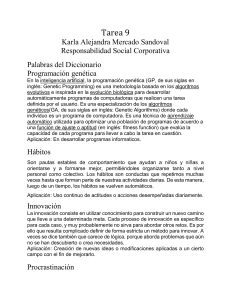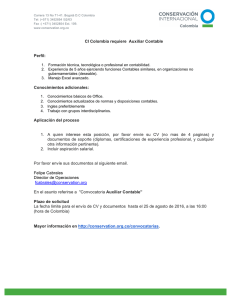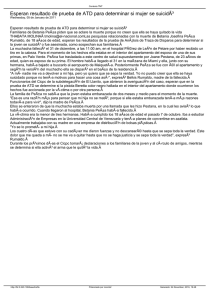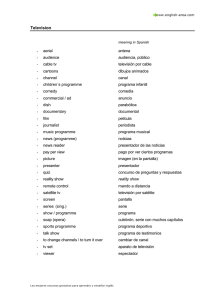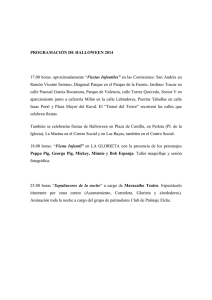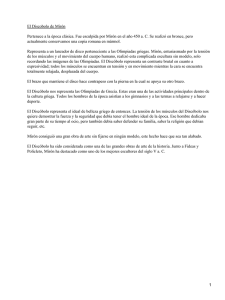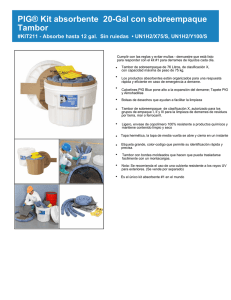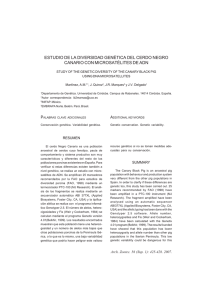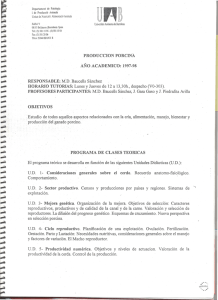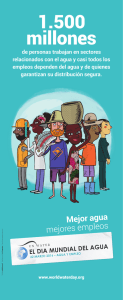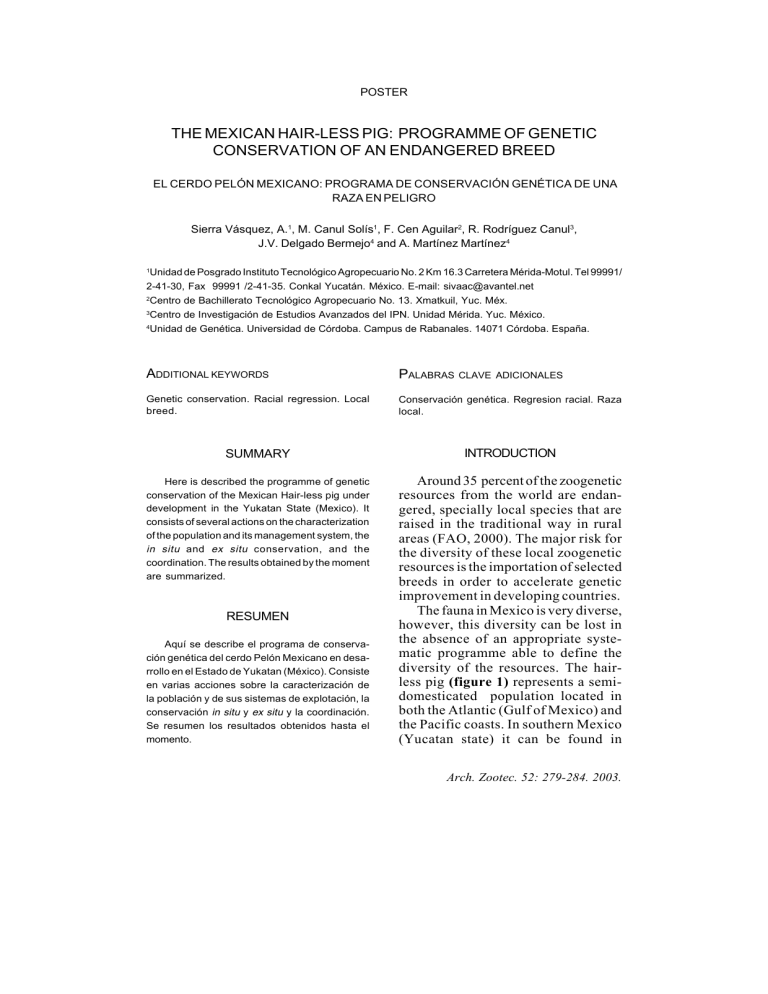
POSTER THE MEXICAN HAIR-LESS PIG: PROGRAMME OF GENETIC CONSERVATION OF AN ENDANGERED BREED EL CERDO PELÓN MEXICANO: PROGRAMA DE CONSERVACIÓN GENÉTICA DE UNA RAZA EN PELIGRO Sierra Vásquez, A.1, M. Canul Solís1, F. Cen Aguilar2, R. Rodríguez Canul3, J.V. Delgado Bermejo4 and A. Martínez Martínez4 1 Unidad de Posgrado Instituto Tecnológico Agropecuario No. 2 Km 16.3 Carretera Mérida-Motul. Tel 99991/ 2-41-30, Fax 99991 /2-41-35. Conkal Yucatán. México. E-mail: sivaac@avantel.net 2 Centro de Bachillerato Tecnológico Agropecuario No. 13. Xmatkuil, Yuc. Méx. 3 Centro de Investigación de Estudios Avanzados del IPN. Unidad Mérida. Yuc. México. 4 Unidad de Genética. Universidad de Córdoba. Campus de Rabanales. 14071 Córdoba. España. ADDITIONAL KEYWORDS PALABRAS CLAVE Genetic conservation. Racial regression. Local breed. Conservación genética. Regresion racial. Raza local. SUMMARY INTRODUCTION Here is described the programme of genetic conservation of the Mexican Hair-less pig under development in the Yukatan State (Mexico). It consists of several actions on the characterization of the population and its management system, the in situ and ex situ conservation, and the coordination. The results obtained by the moment are summarized. Around 35 percent of the zoogenetic resources from the world are endangered, specially local species that are raised in the traditional way in rural areas (FAO, 2000). The major risk for the diversity of these local zoogenetic resources is the importation of selected breeds in order to accelerate genetic improvement in developing countries. The fauna in Mexico is very diverse, however, this diversity can be lost in the absence of an appropriate systematic programme able to define the diversity of the resources. The hairless pig (figure 1) represents a semidomesticated population located in both the Atlantic (Gulf of Mexico) and the Pacific coasts. In southern Mexico (Yucatan state) it can be found in RESUMEN Aquí se describe el programa de conservación genética del cerdo Pelón Mexicano en desarrollo en el Estado de Yukatan (México). Consiste en varias acciones sobre la caracterización de la población y de sus sistemas de explotación, la conservación in situ y ex situ y la coordinación. Se resumen los resultados obtenidos hasta el momento. ADICIONALES Arch. Zootec. 52: 279-284. 2003. SIERRA VÁSQUEZ ET AL. Statistical analyses are performed using the Statistic programme for Windows (version 5.1). 2A. CHARACTERISATION OF THE POPULATION Figure 1. Hair-less pigs tipic of Yucatan. (Cerdo pelón típico de Yucatán). remote communities. Although, in the last three decades it has been replaced in the traditional breeding system and its records have diminished astonishingly. This has been due to the constant introduction of selected breeds in pig farms. This strategy has led to the hair-less pig becoming an endangered species in Mexico (Anderson et al., 1999; Sierra, 2000). The purpose of this programme is to develop strategies of rescue and to guarantee the genetic conservation of this endangered species. MATERIAL AND METHODS The programme of genetic conservation of this endangered breed is composed of seven strategies that are interrelated. 1A. POPULATION STUDIES The compilation of data, through questionnaires, from direct visits to the local producers: After the census, another kind of questionnaire and photos are based on characteristics of the animals. The information is captured in a data base (Microsoft-Excel). Composed of three types, 2.1. Morphology. It is performed for pigs that are enclosed in the racial standard proposed by López et al. (1999). All information is first collected individually in the field and then captured in Excel. Statistical analysis is performed in the Statistic Analysis programme (version 6.1) (Sas, 1996) and Statistic for Windows (version 5.1). 2.2. Zootechnic: consists of the capture of productive and reproductive parameters registered in pioneer hair-less pigs of the genetic conservation centre of the hair-less pig. Through a registration model designed for this purpose. Statistical analyses were performed using descriptive statistic (Sas, 1996). 2.3. Genetics. Blood and hair samples are collected by venous puncture of the jugular and complete extraction of the bulb respectively. The DNA extraction and its analysis with molecular markers (micro satellites) through PCR (Polymerase Chain Reaction) is currently being performed in the Laboratory of Molecular Genetic of the University of Cordoba (Spain). Twenty-six micro-satellites recommended by the FAO/ISAG will be used for the studies of genetic diversity (FAO, 1998). The methodology is that proposed by Martínez (2001), previously for the Iberian pig. The allelic frequencies and the index or heterogeneity will be performed using the packages TFPGA v. 1.3 (Miller, 1997) and Microsat v. 1.5b (Minch, 1998) for Apple Macintosh. Archivos de zootecnia vol. 52, núm. 198, p. 280. MEXICAN HAIR-LESS PIG 3A. GENETIC CONSERVATION IN SITU Consists of the creation of three nuclei of conservation of live animals, each nucleus will be composed of 25 pigs of reproductive age: 20 sows and 5 boars, animals should come from different exploitations and from pigs selected based on their major phenotypic diversity. All cross-breeding will be controlled and non-controlled registering all the productive and reproductive events with the purpose of conserving the maximum genetic variability avoiding the minimum increase of consanguinity by generation. Non-suckling pigs (45 days) will be sent to the rescue centre, In these areas, all animals will grow to the puberty and at this point the programme will decide if they are discarded or selected for future reproduction programmes. Animals will be exchanged with all producers from the conservation programme. 4A. INTEGRATION OF A MULTIDISCIPLINARY AND INTERDISCIPLINARY NETWORK This network will have international and national recognising with the mission to reinforce all the activities focused in the genetic conservation of hair-less pigs in Yucatan. 5A. LEGAL CONSTITUTION OF AN ASSOCIATION FOR FARMERS OF HAIR-LESS PIGS Consists of the identification and organisation of local farmers for the hair-less pig and to support the legal registration. 6A. INDUSTRIALISATION OF PORK PRODUCTS FROM THE HAIR-LESS PIG Pigs that are not selected according to their genealogic antecedents, phenotypic and productive characteristics, will be used for industrialisation and their sub-products will be used as ecological products. This strategy will help support the maintenance and operation of the programme of conservation. 7A. GENETIC CONSERVATION (EX SITU) Finally, all pigs previously detected as positive from the previous stages of the programme (maximum genetic variability), will be used to collect semen and embryos. This strategy will allow the creation of a national genetic bank with the guarantee to provide sufficient genetic diversity for this resource for future approaches. RESULTS AND DISCUSSION FIRST. STRATEGY The total population of the hair-less pig is still under study, however, the programme has detected at least 500 pure pigs (sows and boars at reproductive age). These findings confirm that this breed is endangered. They are located mainly in Maxcanu, Tekax, Valladolid, Mérida and Tizimin. The northern area of the Yucatan state and the coast did not reveal the presence of the hair-less pig. On the other hand, local people tend to exploit the resource without any management strategy and lack of commercialisation due to its low economic importance. The programme has detected that in 70 percent of the cases local families raise free-range pigs with domestic waste as a way of saving. In this sense, the genetic conservation of the hairless pig programme could be successful Archivos de zootecnia vol. 52, núm. 198, p. 281. SIERRA VÁSQUEZ ET AL. in the area and elsewhere if all the procedures are followed according to the guidelines of the network. 2ND. STRATEGY With respect to the morphologic characterisation, 25 morphological variables: 18 quantitative and 7 qualitative in 140 hair-less pig have been analysed. The productive and reproductive parameters are shown in table I. They were evaluated in sows of the hair-less pig raised in a conservationist nuclei. The global fertility observed was higher than in those reported for selected breeds. In the same way, the interval between parturition sand open days are adequate taking into account the management followed in a nucleus. The size and weight of the offspring from their birth to weaning (off suckling) were lower than that reported by Castro (1981) and the weight from birth to weaning (45 days) was also Table I. Reproductive and productive parameters in the Mexican Hair-less pig. (Parámetros productivos y reproductivos en el cerdo Pelón Mexicano). Parámetro Global fecundity Size of the litter Interval between parturitions (days) Open days weigh from the litter to the birth (kg) weigh to the birth (g) weigh to the 15 days (kg) weigh to the 30 days(kg) weigh to the 45 days (kg) weigh litter to the weaning (kg) Preweaning Mortality X ± D.E. (percent) 93.3 5.7 174.5 68.5 4.74 794.5 1.8 2.7 3.7 16.6 27.3 lower than that reported by Cenobio (1993) for hair-less pigs, due to their intensive management during their raising. The mortality during their suckling period was higher and it could be due to two major causes, the first could be related to the poor infrastructure destined for the raising of pigs and the second could be related to the presence of the hurricane that devastated the Yucatan state in September, 2002. In this sense, the lower results of the parameters can increase by using better, more appropriate structures and better practices of management. Regarding the genetic characterisation, 102 samples of DNA have been isolated, from 102 samples (33 from hair and 69 from blood samples). Biodiversity is under study with 26 micro-satellites recomended by FAO/ISAG. 3RD. STRATEGY A nuclei of 25 hair-less pig (20 sows and 5 boars) at reproductive age and 60 offspring with ages ranging from 1 to 8 months, are evaluated after suckling (45 days) and puberty (6.5 to 7 months) and will be selected as future replacements. Animals are exchanged in the communities selected from the genetic conservation programme. At the moment, 5 boars are in the communities of Seye, Tizimín and Kochol to diminish the genetic erosion. In the same way, 6 soaws from the same communities have been introduced in the centre to increase the genetic variability. 4TH. STRATEGY At the moment the programme has a work team of 10 persons belonging to different institutions, local, national and Archivos de zootecnia vol. 52, núm. 198, p. 282. MEXICAN HAIR-LESS PIG international, all of them with the common interest of rescuing the hairless pig. The team has the recognition of the Red Iberoamericana de Ciencia y Tecnología para el Desarrollo (CYTED) and of the Consejo Nacional de Recursos Genéticos Pecuarios en México (CONARGEN). Some of the results of the network have been presented in an international congress based on conservation of local resources held in Yucatan. In the same way, some courses and international projects have been developed. 5TH. STRATEGY This strategy is on development and it has the participation of 8 farmers of the hair-less pig breed. The objective is to fulfil at least 10 official registrations. 6TH. STRATEGY The pig products have been indus- trialised: 13 pigs discarded from the programme were used to prepare a regional local dish known as roast pork Cochinita Pibil. In the same way the pork products have been industrialised as jam, bacon, sausage and chuletas in the traditional way. This strategy is having great demand by locals as it is commercialised as an ecological product. Some studies on the nutritional factors of carcasses and sensorial tests on pork products are still on its way. 7TH. STRATEGY This strategy will be performed at the end of the conservation programme when the programme has characterized all hair-less pigs that provide the maximum genetic variability with the minimum increasing of consanguinity. These animals will provide the samples of semen and ova for future conservative studies. REFERENCES Anderson, S., N. Ferráes y T. Rivera. 1999. La población del cerdo Criollo en Yucatán, México: Estado e Impacto Genético. En: “Memorias del Seminario Internacional sobre Agrodiversidad Campesina”. Universidad Autónoma del Estado de México. Toluca, Méx. Pp 257-266. Castro, G.E. 1981. Importancia que ejercen algunos factores ambientales y el efecto del semental sobre el tamaño y peso de la camada al nacimiento y al destete en el cerdo Pelón Mexicano. Tesis de lic. Fac. de Med. Vet. Y Zoot. UNAM. México, D.F. Cenobio, S.L. 1993. Evaluación del comportamiento reproductivo de un lote de cerdas Pelón Mexicano en la etapa de lactancia en el altiplano. Tesis de Lic.. Fac. de Med. Vet. y Zoot. UNAM. México, D.F. FAO. 1998. Secondary guidelines for development of national farm animal genetic resources management plants: Management of small population at risk, FAO, Rome. FAO. 2000. Peligra la diversidad genética de los animales de granja. <http://www.fao.org/ ag/esp/revista/0011sp2.htm. López, M.J.R., G.R. Martínez y R.G. Salinas. 1999. El Cerdo Pelón Mexicano. Antecedentes y Perspectivas. Ciencia y Cultura Latinoaméricana, S.A. de C.V. México. pp 78. Martínez, M.A. 2001. Caracterización genética del cerdo Ibérico mediante marcadores moleculares. Tesis doctoral. Univ. de Córdoba, Esp. 174pp. Miller, M.P. 1997. Tools for population genetic Archivos de zootecnia vol. 52, núm. 198, p. 283. SIERRA VÁSQUEZ ET AL. analyses (TFPGA) v. 1.3:A windows programme for the analysi of allenzime and molecular population genetic data. Computer software distributed by author. Minch, E. 1998. Microsat v. 1.5b (Macintosh). University of Standford. SAS. 1996. Sas User's Guide: statistics v 6.3 Cary, North. Carolina, USA. Sierra, V.A.C. 2000. Conservación genética del cerdo Pelón en Yucatán y su integración a un sistema de producción sostenible: Primera aproximación. Arch. Zootec., 49: 415-421. Archivos de zootecnia vol. 52, núm. 198, p. 284.
